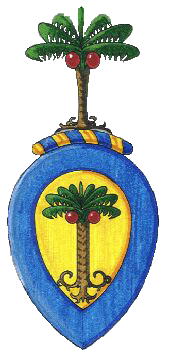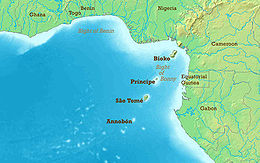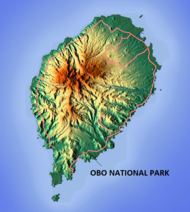geo.wikisort.org - Island
São Tomé Island, at 854 km2 (330 sq mi), is the largest island of São Tomé and Príncipe and is home in May 2018 to about 193,380 or 96% of the nation's population. The island is divided into six districts. It is located 2 km (1¼ miles) north of the equator.
Native name: Ilha de São Tomé | |
|---|---|
 Emblem of São Tome | |
 | |
| Geography | |
| Location | Gulf of Guinea |
| Coordinates | 0°14′N 6°36′E |
| Archipelago | Cameroon line |
| Area | 859 km2 (332 sq mi) |
| Length | 48 km (29.8 mi) |
| Width | 32 km (19.9 mi) |
| Highest elevation | 2,024 m (6640 ft) |
| Highest point | Pico de São Tomé |
| Administration | |
São Tomé and Príncipe | |
| Districts | 6 |
| Largest settlement | São Tomé (pop. 71,868) |
| Demographics | |
| Population | 193,380 (2018) |
| Pop. density | 225/km2 (583/sq mi) |
| Ethnic groups | Mestico, angolares (descendants of Angolan slaves), forros (descendants of freed slaves), servicais (contract laborers from Angola, Mozambique, and Cape Verde), tongas (children of servicais born on the islands), Europeans (primarily Portuguese) |

Geography

São Tomé Island is about 48 kilometres (30 miles) long (north-south) by 32 kilometres (20 miles) wide (east-west). It rises to 2,024 metres (6,640 feet) at Pico de São Tomé and includes the capital city, São Tomé, on the northeast coast. The nearest city on mainland Africa is the port city of Port Gentil in Gabon located 240 kilometres (150 miles) to the east.
The island is surrounded by a number of small islands, including Ilhéu das Rolas, Ilhéu das Cabras and Ilhéu Gabado.
Languages
The main language is Portuguese, but there are many speakers of Forro and Angolar (Ngola), two Portuguese-based creole languages. The name "Sao Tome" is Portuguese for "Saint Thomas."
Geology
The entire island of São Tomé is a massive shield volcano that rises from the floor of the Atlantic Ocean, over 3,000 m (10,000 ft) below sea level. It formed along the Cameroon line, a line of volcanoes extending from Cameroon southwest into the Atlantic Ocean. Most of the lava erupted on São Tomé over the last million years has been basalt. The youngest dated rock on the island is about 100,000 years old, but numerous more recent cinder cones are found on the southeast side of the island.
Environment and economy
The higher slopes of the island are forested and form part of the Parque Natural Obô de São Tomé, but agriculture is important near the north and east coasts. The chief exports are cocoa, coffee, copra, and palm products, while there is also a fishing industry.
Large reserves of oil are in the ocean between Nigeria and São Tomé. The discovery has been lamented by some as endangering the nation's political stability and natural environment. In response to these concerns the government of São Tomé and Príncipe has drawn up legislation in an attempt to ensure the efficient and equitable use of oil revenues over time.
Natural history
Birds
The island has a total of 63 regular bird species, plus an additional 36 vagrant and unconfirmed species. Of these, 19 are endemic and 3 near endemic; in addition, the local subspecies of olive ibis (Bostrychia olivacea bocagei) and maroon pigeon (Columba thomensis) are endemic and considered critically endangered. Six species are considered vulnerable, and two critically endangered (São Tomé fiscal and São Tomé grosbeak).[1][2]
Administrative divisions
São Tomé is divided into the following six districts (seat within brackets):
- Água Grande (São Tomé)
- Cantagalo (Santana)
- Caué (São João dos Angolares)
- Lembá (Neves)
- Lobata (Guadalupe)
- Mé-Zóchi (Trindade)
Towns and villages
Villages on the island include:
- Agua-Coco
- Agua Ize
- Alice
- Alto Douro
- Andrade
- Bela Vista
- Blublu
- Bom Successo
- Buenos Aires
- Dona Augusta
- Dona Eugenia
- Enjale
- Formiga
- General Fonseco
- Graça
- Granja
- Guadalupe
- Guegue Norte
- Henrique
- Java
- Lemos
- Mbombo
- Mbondi
- Monte Café
- Monte Herminios
- Monte Rosa
- Neves
- Nova Olinda
- Nzumbi
- Plato Café
- Ponta Figo
- Portinho
- Porto Alegre
- Preserverança
- Quimpo
- Ribeira Afonso
- Santa Catarina
- Santa Clotilde
- Santa Cruz
- Santa Josefina
- Santana
- Santo António
- São João dos Angolares
- São José
- São Tomé
- Saudade
- Trindade
- Ubabundo
- São Tomé Island
- São Sebastião Lighthouse
- Boca do Inferno, São Tomé
- Pico Cão Grande, São Tomé Island
- Fauna in Lobata District, São Tomé
- Coffee production in São Tomé
- Igreja de Nossa Senhora de Guadalupe, in Guadalupe, São Tomé Island.
- São Tomé
- Lagoa Azul, STP
- One of the traditional Roças in São Tomé and Príncipe
- Cocoa beans drying, São Tomé
- Shrimp and French fries as served in a local hotel, São Tomé
- Guadalupe, São Tomé
- Sea turtle as seen in São Tomé Island
- Municipal market of São Tomé City
References
- "Sao Tome". Global Volcanism Program. Smithsonian Institution.
- CIA Word Fact Book
На других языках
[de] São Tomé (Insel)
Die Insel São Tomé (deutsch Sankt Thomas) im Golf von Guinea ist ein Teil des afrikanischen Staates São Tomé und Príncipe. Die gleichnamige Stadt São Tomé ist Hauptstadt des Staates.- [en] São Tomé Island
[es] Isla de Santo Tomé
Santo Tomé o Santo Tomás (en portugués, São Tomé) es la isla mayor de Santo Tomé y Príncipe. Esta isla y algunos islotes conforman la Provincia de Santo Tomé, que se divide en seis distritos. La isla se encuentra a 2 km al norte de la línea ecuatorial. Tiene 48 km de largo y 32 km de ancho. Su altura máxima es el Pico de Santo Tomé (2.024 m) e incluye la capital del país, Santo Tomé, en la costa norte. La ciudad más cercana en el continente africano es la ciudad de Port Gentil en Gabón a 240 km al este.[fr] São Tomé (île)
São Tomé ou Sao Tomé, autrefois aussi nommée Saint-Thomas, Saint-Thomé ou Saint-Thomée[1] (formes attestées mais peu usuelles), est l'île principale de Sao Tomé-et-Principe.[it] São Tomé (isola)
São Tomé è un'isola del Golfo di Guinea nell'Oceano Atlantico, appartenente allo Stato africano di São Tomé e Príncipe e ricompresa nella provincia omonima.[ru] Сан-Томе (остров)
Сан-Томе́ (порт. São Tomé) — остров в Гвинейском заливе Атлантического океана. Самый крупный из островов, составляющих государство Сан-Томе и Принсипи.Другой контент может иметь иную лицензию. Перед использованием материалов сайта WikiSort.org внимательно изучите правила лицензирования конкретных элементов наполнения сайта.
WikiSort.org - проект по пересортировке и дополнению контента Википедии














